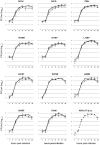Recombinant herpes simplex virus type 1 strains with targeted mutations relevant for aciclovir susceptibility
- PMID: 27426251
- PMCID: PMC4947914
- DOI: 10.1038/srep29903
Recombinant herpes simplex virus type 1 strains with targeted mutations relevant for aciclovir susceptibility
Abstract
Here, we describe a novel reliable method to assess the significance of individual mutations within the thymidine kinase (TK) gene of herpes simplex virus type 1 (HSV-1) to nucleoside analogue resistance. Eleven defined single nucleotide polymorphisms that occur in the TK gene of clinical HSV-1 isolates and a fluorescence reporter were introduced into the HSV-1 strain 17(+) that had been cloned into a bacterial artificial chromosome. The susceptibility of these different strains to aciclovir, penciclovir, brivudin, and foscarnet was determined with a modified cytopathic effect reduction assay. The strains were also tested for their aciclovir susceptibility by measuring the relative fluorescence intensity as an indicator for HSV-1 replication and by quantifying the virus yield. Our data indicate that the amino acid substitutions R41H, R106H, A118V, L139V, K219T, S276R, L298R, S345P, and V348I represent natural polymorphisms of the TK protein, whereas G61A and P84L mediate broad cross-resistance against aciclovir, penciclovir, brivudin, and susceptibility to foscarnet. This method allows the definition of the resistance genotype of otherwise unclear mutations in the TK gene of HSV-1. Thus, it provides a scientific basis for antiviral testing in clinical isolates of patients suffering from serious diseases and will facilitate testing of new antivirals against HSV-1.
Figures



Similar articles
-
Genotypic and phenotypic characterization of the thymidine kinase of ACV-resistant HSV-1 derived from an acyclovir-sensitive herpes simplex virus type 1 strain.Antiviral Res. 2002 Dec;56(3):253-62. doi: 10.1016/s0166-3542(02)00131-6. Antiviral Res. 2002. PMID: 12406508
-
Single nucleotide polymorphisms of thymidine kinase and DNA polymerase genes in clinical herpes simplex virus type 1 isolates associated with different resistance phenotypes.Antiviral Res. 2014 Jul;107:16-22. doi: 10.1016/j.antiviral.2014.03.015. Epub 2014 Apr 18. Antiviral Res. 2014. PMID: 24747042
-
Efficacy of anise oil, dwarf-pine oil and chamomile oil against thymidine-kinase-positive and thymidine-kinase-negative herpesviruses.J Pharm Pharmacol. 2008 Nov;60(11):1545-50. doi: 10.1211/jpp/60.11.0017. J Pharm Pharmacol. 2008. PMID: 18957177
-
Relevance of non-synonymous thymidine kinase mutations for antiviral resistance of recombinant herpes simplex virus type 2 strains.Antiviral Res. 2018 Apr;152:53-57. doi: 10.1016/j.antiviral.2018.02.004. Epub 2018 Feb 7. Antiviral Res. 2018. PMID: 29427675
-
Novel resistance-associated mutations of thymidine kinase and DNA polymerase genes of herpes simplex virus type 1 and type 2.Antivir Ther. 2011;16(8):1297-308. doi: 10.3851/IMP1870. Antivir Ther. 2011. PMID: 22155911
Cited by
-
AMPK protects endothelial cells against HSV-1 replication via inhibition of mTORC1 and ACC1.Microbiol Spectr. 2023 Sep 13;11(5):e0041723. doi: 10.1128/spectrum.00417-23. Online ahead of print. Microbiol Spectr. 2023. PMID: 37702499 Free PMC article.
-
Relative Contributions of the cGAS-STING and TLR3 Signaling Pathways to Attenuation of Herpes Simplex Virus 1 Replication.J Virol. 2020 Feb 28;94(6):e01717-19. doi: 10.1128/JVI.01717-19. Print 2020 Feb 28. J Virol. 2020. PMID: 31896590 Free PMC article.
-
A novel bioluminescent herpes simplex virus 1 for in vivo monitoring of herpes simplex encephalitis.Sci Rep. 2021 Sep 21;11(1):18688. doi: 10.1038/s41598-021-98047-z. Sci Rep. 2021. PMID: 34548521 Free PMC article.
References
-
- Pellett P. E. et al.. In Virus Taxonomy Classification and Nomenclature of Viruses (eds King A. M. Q., Adams M. J., & Lefkowitz E. J. ) (Elsevier, 2011).
-
- Sauerbrei A. et al.. Seroprevalence of herpes simplex virus type 1 and type 2 in Thuringia, Germany, 1999 to 2006. Euro Surveill 16 (2011). - PubMed
Publication types
MeSH terms
Substances
LinkOut - more resources
Full Text Sources
Other Literature Sources

